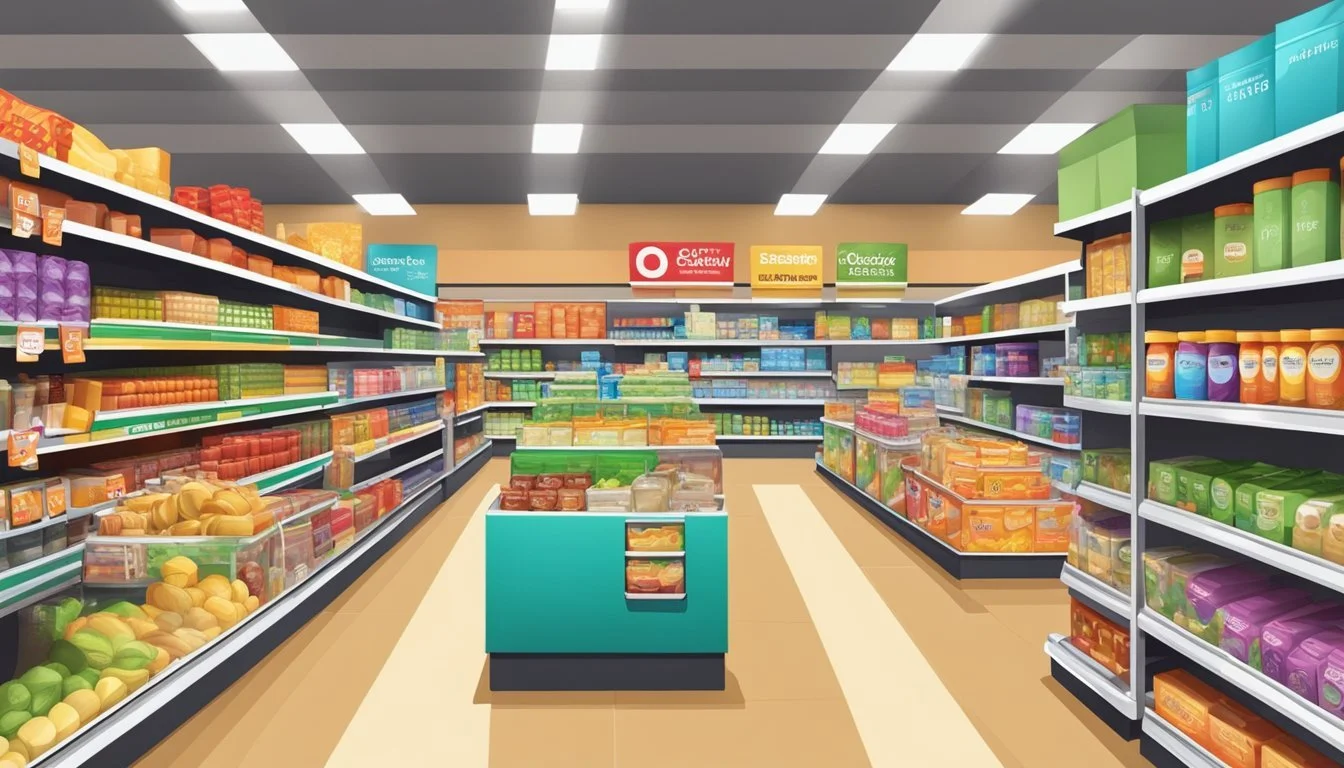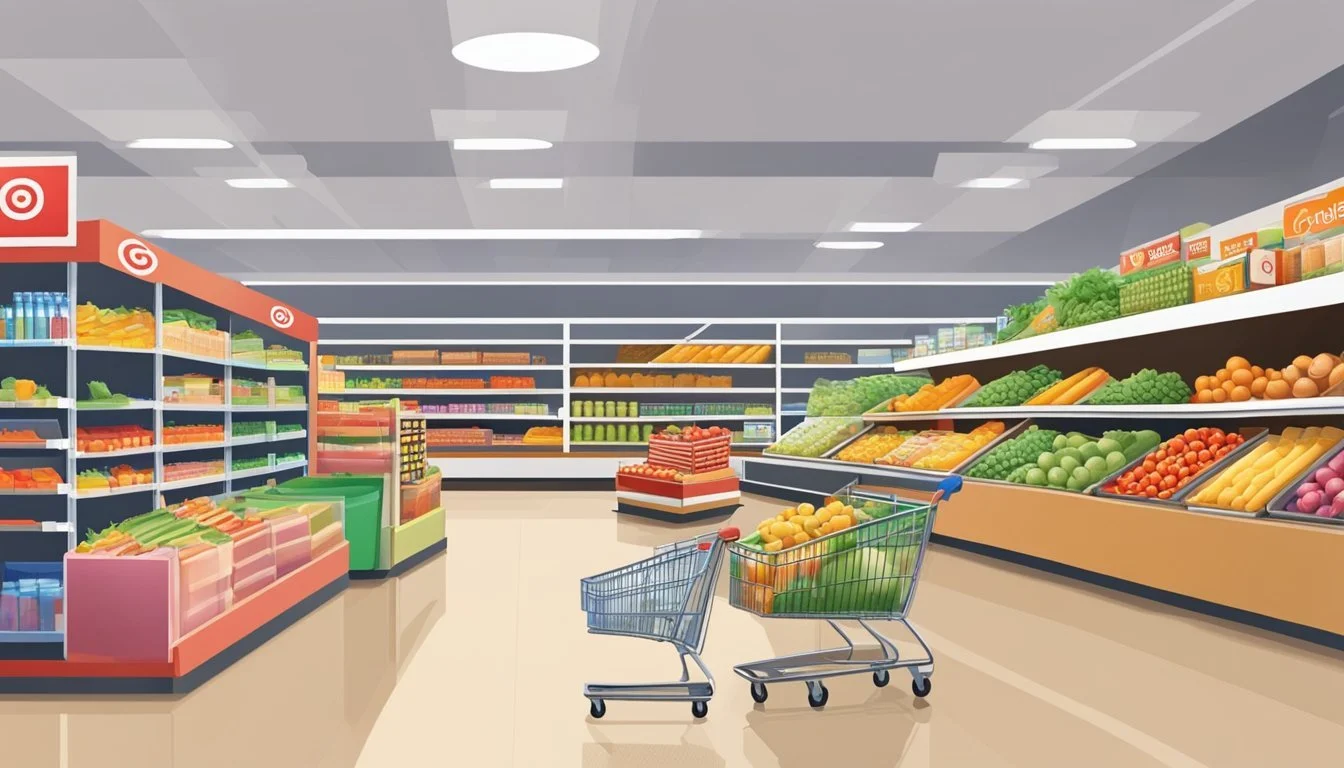Target vs Save Mart
A Comprehensive Comparison of Prices, Selection, and Services
Target and Save Mart are two popular grocery store chains that cater to different consumer needs. Both offer a wide range of products, but they have distinct characteristics that set them apart.
Target is known for its trendy, upscale image and diverse product selection beyond just groceries. The retail giant has expanded its grocery offerings in recent years, focusing on its own private-label brands and convenient shopping experiences. While Target's grocery prices are generally higher than discount chains, it often attracts customers with its stylish store designs and curated product selection.
Save Mart, on the other hand, is a regional supermarket chain primarily focused on groceries. It typically offers competitive prices on a wide variety of food items, including fresh produce, meats, and pantry staples. Save Mart stores are designed with a more traditional supermarket layout, emphasizing efficiency and value for shoppers primarily interested in food purchases.
Overview of Target and Save Mart
Target and Save Mart are two distinct retail chains operating in the United States grocery market. They differ significantly in their history, scale, and focus areas.
History and Brand Image
Target Corporation traces its roots back to 1902 when George Dayton founded Goodfellow Dry Goods in Minneapolis. The company rebranded as Target in 1962, launching its first discount store. Target has since cultivated an image of affordable style and design-focused products.
Save Mart Supermarkets began in 1952 when Nick Tocco and Mike Piccinini opened their first store in Modesto, California. The company grew steadily, focusing on fresh produce and meat. Save Mart has maintained a reputation for quality groceries and strong community ties.
Geographical Presence
Target operates nationally with over 1,800 stores across all 50 U.S. states. Its stores are typically found in suburban areas and city centers, often as anchor tenants in shopping centers.
Save Mart's presence is more regionally focused. The chain primarily serves Northern California and Northern Nevada. It operates around 200 stores under various banners including Save Mart, Lucky, and FoodMaxx.
Target and Save Mart Market Position
Target positions itself as a multi-category retailer offering groceries alongside clothing, electronics, and home goods. Its grocery section expanded significantly in 2009 with the introduction of fresh produce and perishables.
Save Mart is a dedicated grocery chain, specializing in food and household essentials. It competes directly with other supermarket chains and emphasizes its fresh departments and local produce sourcing.
Target aims for a middle to upper-middle income demographic, while Save Mart caters to a broader range of customers with its various store formats.
Shopping Experience
Target and Save Mart offer distinct shopping environments, each with its own strengths and weaknesses. Their approaches to store design, customer service, and online platforms shape the overall experience for shoppers.
Store Layout and Design
Target stores feature a clean, modern aesthetic with wide aisles and clear signage. The retailer emphasizes an inviting atmosphere through its use of bright lighting and eye-catching displays. Target's layout often groups complementary items together, encouraging browsing and impulse purchases.
Save Mart, in contrast, focuses on a more traditional grocery store layout. Aisles are typically narrower, with a greater emphasis on efficiency for quick shopping trips. Save Mart stores often have a more utilitarian design, prioritizing function over style.
Both chains organize their produce sections near the entrance, but Target tends to integrate its grocery offerings with other departments, while Save Mart keeps food items more centralized.
Customer Service
Target invests heavily in customer service training, aiming to provide a friendly and helpful experience. Employees are often visible on the sales floor, ready to assist shoppers. The company emphasizes a team-oriented approach, with staff members cross-trained to handle various duties.
Save Mart's customer service model is more focused on efficiency and product knowledge. Staff members are typically concentrated in specific departments, such as the deli or bakery. This approach can lead to more specialized assistance but may result in fewer employees available for general inquiries.
Both retailers offer self-checkout options, but Target tends to have more manned registers during peak hours.
In-Store Experience Versus Online Shopping
Target has made significant strides in integrating its in-store and online experiences. The company's app allows customers to locate items in-store, check prices, and access exclusive deals. Target's "Order Pickup" and "Drive Up" services blend digital convenience with physical store benefits.
Save Mart's online presence is less developed. While the chain offers online ordering and delivery through third-party services in some areas, its e-commerce platform is not as robust as Target's. Save Mart's focus remains primarily on the in-store experience.
In-store prices at both retailers are generally consistent with their online offerings. However, Target often features web-only deals and a broader selection of non-grocery items on its website.
Product Assortment and Selection
Target and Save Mart offer distinct product assortments to cater to different customer needs. Their selections vary in terms of fresh produce quality, store brand offerings, national brand availability, and unique product lines.
Quality of Fresh Produce
Target's fresh produce section has improved in recent years. The retailer focuses on offering a curated selection of fruits and vegetables. While the variety may be limited compared to traditional grocery stores, Target emphasizes quality and freshness.
Save Mart, being a dedicated grocery chain, typically provides a wider array of fresh produce. Their selection often includes both conventional and organic options. Save Mart's produce departments are generally larger and more comprehensive than Target's.
Both stores strive to maintain quality standards, but Save Mart's specialized focus on groceries often translates to fresher produce and more frequent restocking.
Variety of Store Brands
Target's flagship store brand, Good & Gather, covers a wide range of food products. This line emphasizes quality ingredients and taste at competitive prices. Target also offers other private labels like Market Pantry for everyday essentials.
Save Mart carries its own store brands, including the Save Mart label and Pacific Coast Selections. These brands cover various product categories but may not have the same breadth as Target's Good & Gather line.
Target's store brands often receive praise for their packaging design and product innovation. Save Mart's private labels focus more on providing value alternatives to national brands.
Availability of National Brands
Both Target and Save Mart stock a range of national brands, but their assortments differ. Target tends to carry popular mainstream brands across various categories. Their selection is curated to meet the needs of their typical shopper.
Save Mart, as a dedicated grocery store, often offers a more extensive selection of national brands. This includes multiple options within each product category and specialty items that may not be found at Target.
For everyday staples and well-known brands, both stores provide adequate options. However, Save Mart generally offers more variety and depth in national brand selection.
Unique Offerings
Target distinguishes itself with exclusive designer collaborations and limited-edition products. These often extend to home goods, clothing, and seasonal items, setting Target apart from traditional grocers.
The retailer also carries its own beauty and personal care brands like Versed and Native, which are not typically found in conventional grocery stores.
Save Mart focuses more on food-related unique offerings. This may include local and regional products, specialty ethnic foods, and a wider variety of fresh-prepared meals and deli items.
While Target excels in non-food unique products, Save Mart's strength lies in its diverse food offerings and local selections.
Pricing and Value for Money
Target and Save Mart offer different pricing strategies and value propositions for grocery shoppers. Both stores aim to provide competitive prices and savings opportunities, but their approaches vary.
Everyday Prices and Discounts
Target focuses on competitive everyday pricing for groceries, particularly with its Good & Gather store brand. The retailer frequently runs promotions and offers digital coupons through its Target Circle program. These deals can provide significant savings on select items each week.
Save Mart, on the other hand, tends to have slightly higher everyday prices but offers frequent sales and promotions. The store's weekly ad features discounted prices on various products, allowing savvy shoppers to stock up on essentials at reduced costs.
Both stores offer price matching policies, though Target's is generally more comprehensive. Target will match prices from select online and local competitors, including Amazon.
Price Comparison with Competitors
When compared to major competitors like Walmart, Target's grocery prices are often slightly higher. A recent price comparison found Target to be about 5.4% more expensive than Walmart for a basket of 12 key food items.
Save Mart's pricing typically falls in the middle range among grocery stores. It's usually not the cheapest option, but it's also not the most expensive. The store's prices are generally competitive with other regional supermarket chains.
For produce, Target often beats Save Mart on prices for items like bananas and grapes. However, Save Mart may have better deals on seasonal fruits and vegetables.
Loyalty Programs and Savings
Target's loyalty program, Target Circle, offers 1% earnings on purchases, personalized deals, and birthday rewards. Members can also vote on which local nonprofits Target should support.
Save Mart's rewards program provides digital coupons and personalized offers based on shopping history. Members earn points on purchases, which can be redeemed for discounts on future shopping trips.
Both programs are free to join and can lead to substantial savings for regular shoppers. Target Circle tends to offer more diverse benefits, while Save Mart's program focuses primarily on grocery-specific savings.
Services and Conveniences
Target and Save Mart offer various services to enhance the shopping experience. Both stores provide options for convenient shopping, delivery, and in-store amenities.
Delivery and Shipping Options
Target partners with Shipt for same-day delivery on groceries and household essentials. Customers can get free 2-day shipping on orders over $35 or when using a Target RedCard. Target also offers free standard shipping on most items.
Save Mart provides delivery through Instacart in select areas. Fees vary based on order size and delivery time. Save Mart does not offer free shipping options for online orders.
Target's wider range of products and free shipping thresholds give it an edge in delivery services.
Store Pickup and Same-Day Services
Target excels in this area with Drive Up service. Customers can order online and have items brought to their car for free within 2 hours. Order Pickup is available for in-store collection.
Save Mart offers curbside pickup at select locations. Customers can order online and pick up their groceries without entering the store.
Target's faster turnaround times and wider availability of pickup services across locations make it more convenient for many shoppers.
Additional In-Store Services
Target houses CVS pharmacies in many stores, offering prescription services and health consultations. Some locations feature Ulta Beauty sections, providing a wide range of cosmetics and skincare products.
Save Mart pharmacies offer prescription services, immunizations, and health screenings. Many stores include floral departments and deli counters with prepared foods.
Both stores provide money services like check cashing and bill payment. Target's inclusion of popular brands like CVS and Ulta Beauty within its stores offers added convenience for one-stop shopping.
Store Brands and Exclusive Products
Target and Save Mart both offer their own store brands and exclusive product lines. These private label offerings provide unique options and potential savings for shoppers.
Comparison of Store Brand Quality
Target's Good & Gather brand has gained popularity for its quality and value. The line includes over 2,000 products free from artificial flavors, colors, and high-fructose corn syrup. Good & Gather items span categories like produce, dairy, and pantry staples.
Save Mart's store brands focus on affordability. Their private label products cover essentials across grocery departments. While perhaps less extensive than Target's offering, Save Mart aims to provide budget-friendly alternatives to national brands.
Quality perceptions vary between the two retailers' store brands. Target has invested heavily in Good & Gather's development and marketing. Save Mart's private labels maintain a more utilitarian positioning.
Exclusive Partnerships and Collections
Target stands out for its exclusive designer partnerships. The retailer frequently collaborates with well-known brands and personalities to create limited-edition collections. These exclusive lines often generate excitement and drive foot traffic to stores.
One notable Target partnership is with Chip and Joanna Gaines. Their Hearth & Hand with Magnolia line offers home decor and lifestyle products exclusively at Target. This collection appeals to fans of the couple's design aesthetic.
Save Mart's exclusive offerings are more limited. The grocer focuses on regional partnerships with local producers and suppliers. This approach provides customers with unique products tied to their community, though on a smaller scale than Target's national collaborations.
Sustainability and Community Impact
Target and Save Mart both prioritize sustainability and community engagement, but their approaches differ. Each retailer has implemented initiatives to reduce environmental impact and support local communities.
Corporate Social Responsibility Initiatives
Target's corporate social responsibility efforts focus on education, workforce development, and disaster relief. The company has pledged to invest $2 billion in Black-owned businesses by 2025. Target also runs a nationwide school library makeover program.
Save Mart emphasizes food security and hunger relief in its local communities. The retailer partners with food banks and donates surplus food to those in need. Save Mart also supports youth education through scholarship programs and school fundraising initiatives.
Both companies encourage employee volunteerism and offer matching gift programs to amplify their community impact.
Environmental Sustainability Efforts
Target has set ambitious environmental goals, aiming for 100% renewable electricity in its operations by 2030. The retailer is working to make its owned brand products more sustainable and recyclable.
Save Mart focuses on reducing food waste and energy consumption in its stores. The company has implemented energy-efficient lighting and refrigeration systems. Save Mart also promotes reusable bags and offers recycling programs for customers.
Both retailers have increased their offerings of organic and locally sourced products to support sustainable agriculture practices.
Financial Performance and Industry Standing
Target and Save Mart operate in different segments of the retail grocery market, with distinct financial profiles and competitive positions. Target's larger scale and broader product mix contrast with Save Mart's regional focus and traditional supermarket model.
Recent Earnings and Growth
Target reported $106.5 billion in total revenue for fiscal year 2022, a 2.8% increase from the previous year. The company's comparable sales grew 2.2%, driven by a 2.1% increase in traffic. Target's digital sales rose 3.5%, accounting for 18.3% of total sales.
Save Mart, being a privately held company, does not publicly disclose detailed financial information. However, industry estimates suggest the company generates annual revenues between $4-5 billion from its approximately 200 stores across California and Nevada.
Market Share and Competitiveness
Target holds a significant market share in the U.S. retail sector, competing with giants like Walmart and Amazon. In the grocery segment, Target accounts for about 3% of grocery dollars spent nationally. The company has expanded its food offerings and improved its supply chain to enhance competitiveness.
Save Mart operates in a more localized market, primarily competing with regional chains and national players in California and Nevada. The company focuses on fresh produce and local products to differentiate itself from larger competitors.
Target's scale allows for more competitive pricing and a wider product assortment. Save Mart, while smaller, leverages its local connections and community presence to maintain customer loyalty in its operating regions.
Customer Loyalty and Brand Perception
Target and Save Mart employ different strategies to build customer loyalty and shape their brand perception. These efforts impact how shoppers view and interact with each retailer.
Brand Loyalty Among Shoppers
Target has cultivated a loyal following through its emphasis on stylish yet affordable products. Many shoppers, especially young families, view Target as a destination for trendy home goods and clothing alongside groceries. This perception drives repeat visits and brand affinity.
Save Mart focuses on competitive pricing and local community involvement to foster loyalty. Their strategy appeals to budget-conscious shoppers and those who value supporting regional businesses.
Both chains offer loyalty programs. Target's RedCard provides a 5% discount on purchases, while Save Mart's rewards program gives points for grocery spending. These initiatives aim to incentivize repeat shopping and boost customer retention.
Customer Feedback and Ratings
Target generally receives positive customer feedback for its store atmosphere and product selection. Shoppers appreciate the clean, organized layouts and helpful staff. Online ratings for Target stores average around 4 out of 5 stars across various platforms.
Save Mart garners praise for its fresh produce and meat departments. Customers value the quality of perishables and competitive pricing. Save Mart stores typically receive ratings between 3.5 and 4 stars from shoppers.
Both chains face occasional criticism for out-of-stock items or long checkout lines during peak hours. However, Target's self-checkout options and Save Mart's focus on speedy service help mitigate these concerns for many customers.
Conclusion and Final Assessment
Target and Save Mart each offer unique advantages for grocery shoppers. Target excels in store atmosphere, product variety, and brand selection. Its clean, well-organized stores provide a pleasant shopping experience.
Save Mart typically has lower prices on many grocery staples. This can lead to significant savings for budget-conscious consumers, especially on everyday essentials.
Target's private label brands like Good & Gather offer quality products at competitive prices. Save Mart counters with a strong selection of fresh produce and local items.
For convenience, Target's larger stores allow one-stop shopping for groceries and other household needs. Save Mart focuses primarily on food items but may have shorter checkout lines.
Ultimately, the better choice depends on individual priorities. Those seeking the lowest prices on groceries may prefer Save Mart. Shoppers who value store experience and product variety may lean towards Target.
Both stores have strengths in different areas. Savvy consumers can benefit from shopping at both, taking advantage of sales and each store's unique offerings.











